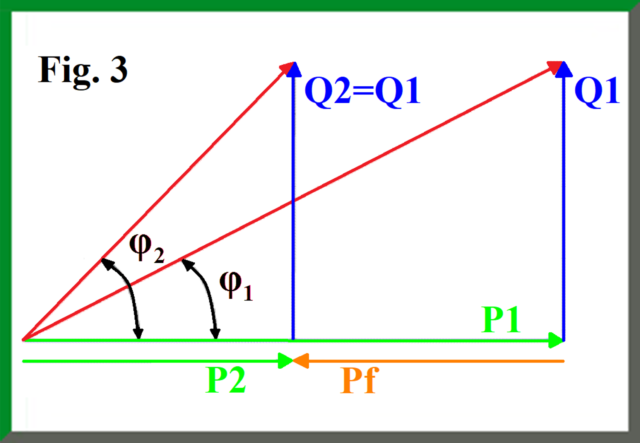Dear friend of Electrisium,
in this article we will present the power factor correction solutions that the company COMAR Condensatori is providing, and, moreover, you will discover the importance of those solutions in case that a photovoltaic system is integrated within the electrical network.
What Is Power Factor and how it can negatively impact the energy bill?

There are three power components within the electrical system:
► the Active Power (P), measured in watts (W), is the component actually used for operating electrical equipment and machines;
► the Reactive Power (Q), measured in volt ampere reactive (VAR), is important for maintaining the electromagnetic field in alternating current (AC) circuits, which permits transformers and motors to operate, without it, the transfer of energy wouldn’t be possible;
► the Apparent Power (S), measured in volt amperes (VA), known as total power, is a combination of the active power and the reactive power.
In the vector diagram from Fig. 1, the active power P is represented by a horizontal vector, while the vector for the apparent power S is lagging the active power by the angle φ and the reactive power vector Q completes the triangle.
Power factor or cos φ, is a measurement of efficiency in the electrical systems and describes the relation between Active Power (P) consumed and apparent Power (S) demanded by the load. It is calculated as the ratio between the active power, measured in watts (W), and the apparent power, measured in volt-amperes (VA).
A reduced power factor means that power is used inefficiently and consequently has significant impact to companies because, it can lead to:
► Overheating damages caused to insulation and equipment;
► Requirements for increasing amount of active power, so higher energy consumption;
► Considerable power loss in the network and high transformer losses;
► Voltage drops in the network resulting in higher overall cost for the grid operator because the lower power factor requires a higher current to supply the loads. That is the reason why consumers whose power factor is below a specified value are requested the payment of penalties on their electricity bill.
The power factor can be corrected by using capacitors to reduce the reactive power in the circuit thus increasing the power factor. A capacitor helps to improve the power factor by relieving the supply line of the reactive power caused by an inductive load, without affecting the operation of that load. Implementing solutions for power factor correction using capacitors increase the efficiency of power supply, while reducing the energy consumption and delivering cost savings on electricity, and, moreover, optimizing the efficiency of renewable energy systems like wind and solar and cogeneration systems.

Power factor correction for an inductive load consists simply of connecting capacitors in parallel with the load. In the vector diagram from Fig. 2, the parallel connected capacitor supplies a reactive power Qc, which cancels some of the initial reactive power Q1, leaving a final reduced reactive power Q2. Accordingly, the apparent power is decreased from S1 to S2 as well as the angle from φ1 to φ2, while the active power P remains constant.
Capacitors can provide 100% of compensated reactive power if required, so that their reactive power equals the reactive power of the inductive load, thus P = S and so cos φ = 1, but in practice a power factor correction of between 95% and 98% (0,95 to 0,98) is usually sufficient.
Basically, power factor correction capacitors increase the carrying capacity of the electrical system which permits additional loads to be added to the system without altering its apparent power.
Through national norms and regulations regarding the admissible power factor and also through related penalty fees, the consumers are encouraged to minimize their consumption of reactive energy and to avoid overly generating reactive power.
Utility companies charge consumers a penalty fee on top of consumption charges when their power factor is less than a specific minimum required.
The impact of photovoltaic system integration on the power factor
The effort to reduce the dependence on fossil fuels for power generation has resulted in the rapid increase of implementation of photovoltaic power generating systems, as a sustainable source of electrical energy and an important solution for addressing environmental issues. Investing in a photovoltaic system is certainly a wise decision, however the introduction of this additional energy supply can lead to significant power quality problems related to the power factor. Unfortunately, many consumers do not take these problems into consideration and are unaware that the integration of a photovoltaic system worsens the power factor and consequently lead to the risk of penalties on the energy bill. Therefore, it is essential to equip the system with adequate power factor correction solution to compensate for these discrepancies.
There are some solar inverters that offer the possibility to be configured to provide limited capacity of power factor correction, either from their excess capacity if the case or by limiting their output capacity. However, the most widespread solution is using a Power Factor Correction (PFC) system that is able to accurately compensate for the reactive power, resulting the required power factor.

As represented in Fig. 3, when there is no photovoltaic system integrated, the active power P1 and the reactive power Q1 drawn from the grid are almost equal so that the power factor cosφ1 is between the required limits. A photovoltaic system usually works in parallel with the grid, so the photovoltaic active power Pf (generated by the photovoltaic system) can support the consumer power demand during the day. The photovoltaic system injects active power Pf when there is solar irradiance, thus, less active power P2 will be needed from the grid, while the reactive power remains unchanged Q1=Q2 because it is determined by the loads, consequently the displacement angle φ increases φ2 > φ1 and the power factor decreases cosφ2 < cosφ1.
COMAR Condensatori is an Italian company which has the know-how and the experience to design and produce single-phase and three-phase capacitors, as well as power factor correction (PFC) systems, at low and medium voltage. The company is focusing to provide power quality solutions, so as to optimize the efficiency of the electrical systems, both through power factor compensation and harmonic content filtering.

COMAR Condensatori offers a wide range of automatic power factor correction systems that can maintain the power factor at the desired value, depending on the harmonic content in the network:
a) DMP-FTV Series
► Maximum harmonic distortion in current allowed in the network THDI(r) = 40%
► Maximum harmonic distortion in current allowed in the capacitors THDI(c) = 90%
b) AAR/100, AAR/600 e AAR/D20 Series, equipped with blocking reactors
► Maximum harmonic distortion in current allowed in the network THDI(r) = 100%
► Maximum harmonic distortion in voltage allowed in the network THDV(r) = 3%, 6%, 20%
All automatic power factor correction systems, with or without blocking reactors, can be equipped with static insertion, for an instantaneous response to load variations.
It is always recommended to carry out the necessary measurements on the electricity grid, to be able to correctly dimension the power factor correction system and to choose the appropriate solution, and, moreover, in order to estimate the total harmonic distortion value (THD).
If the installed photovoltaic system has a power greater than that demanded from the grid and / or there is the possibility that active power is fed into the grid, the Power Factor Controller must be able to operate on „4 quadrants”: two standards relating to the operation of the system as consumer, two additional quadrants related to the operation of the system as a generator. Power Factor Controllers designed for this function are those of the German manufacturer BELUK, pioneer and leading manufacturer in the field of reactive power control. By equipping the power factor correction system with such controller, not only you will have a durable product, but also a reliable one, capable of managing every situation effectively.

In case a photovoltaic system is connected to the grid, the power factor correction (PFC) system should be equipped with metallized polypropylene film capacitors, designed to guarantee the electrical characteristics in particularly heavy-duty applications and built according to the latest quality standards.
COMAR Condensatori developed Cloud Control System, the continuous monitoring solution that can be integrated in the automatic power factor correction systems to meet the increasing market demand for connectivity and security in the energy sector.
In conclusion, integrating a photovoltaic system might not bring optimal savings because of low power factor. A power factor correction technology can bring an improvement in this regard. By correcting the power factor, a company can reduce its electricity costs and increase its profit by saving money on its energy bill.
In case your company is facing a reduced power factor, implementing a power factor correction solution might be an option worth considering. Contact us if you have questions or if you need more information about the power factor correction and how it can help you to save money.
All the best,
The ELECTRISIUM team

